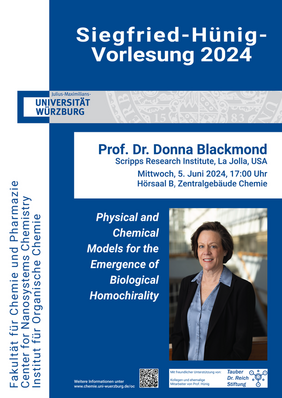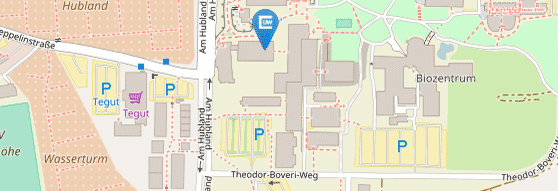Prof. D. Blackmond: "Physical and Chemical Models for the Emergence of Biological Homochirality"
Physical and Chemical Models for the Emergence of Biological Homochirality
| Datum: | 05.06.2024, 17:00 - 18:30 Uhr |
| Kategorie: | Festveranstaltung, Vortrag |
| Ort: | Hubland Süd, Geb. C3 (Zentralbau Chemie), HS B |
| Veranstalter: | Fakultät für Chemie und Pharmazie, Institut für Organische Chemie |
| Vortragende: | Prof. Donna Blackmond |
Das Institut für Organische Chemie lädt ein zur
Siegfried-Hünig-Vorlesung 2024
am 5. Juni 2024 im Hörsaal B.
Die diesjährige Preisträgerin
Prof. Donna Blackmond, Scripps Research Institute, La Jolla, California
trägt vor über
"Physical and Chemical Models for the Emergence of Biological Homochirality"
Programm:
- Get-together bei Kaffee und Gebäck im Foyer ab 16:30 Uhr
- Begrüßung durch Frau Prof. Höbartner
- Siegfried-Hünig-Vorlesung
Donna Blackmond:
Donna G. Blackmond received a PhD in Chemical Engineering from Carnegie Mellon University. She has held professorships in the US (University of Pittsburgh), Germany (Max-Planck-Institut für Kohlenforschung), and the UK (University of Hull; Imperial College London), and she has worked in the pharmaceutical industry (Merck). She is Professor of Chemistry, Department Chair, and the John C. Martin Endowed Chair in Chemistry at Scripps Research Institute, La Jolla, California.
Professor Blackmond is an elected member of several learned societies, including the German Academy of Sciences Leopoldina. She has been recognized for her research including the Wolfson Research Merit Award from the Royal Society, the Max-Planck-Gesellschaft Award for Outstanding Women Scientists, the Arthur C. Cope Scholar Award from the American Chemical Society, and the IUPAC Award for Distinguished Women in Chemistry or Chemical Engineering. In 2021 she received a Humboldt-Forschungspreis from the Alexander von Humboldt Foundation. She is a Simons Investigator in the Simons Foundation Collaboration on the Origins of Life where she studies prebiotic chemistry and the origin of biological homochirality.
Abstract:
The single chirality of the amino acids and sugars that make up the building blocks of life has fascinated scientists and laymen alike since Pasteur’s first painstaking separation of the enantiomorphic crystals of a tartrate salt over 150 years ago. In the past several decades, a number of theoretical and experimental investigations have helped to delineate models for how one enantiomer might have come to dominate over the other from what presumably was a racemic prebiotic world.
Our work has highlighted mechanisms that include either chemical or physical processes, or a combination of both. While much of the scientific driving force for this work arises from an interest in understanding the origin of life, research focusing on mechanisms for the enantioenrichment of chiral molecules has the potential to impact a wide range of applications, most notably in the synthesis and formulation of pharmaceuticals.



